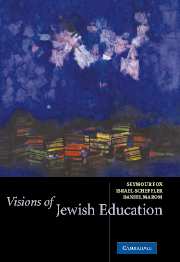Book contents
- Frontmatter
- Contents
- Preface and Acknowledgments
- About the Mandel Foundation
- Introduction
- Part I The Visions Project
- Part II Visions in Detail
- Introduction
- 4 What Must a Jew Study – and Why?
- Supplement: Isadore Twersky
- 5 Jewish Studies in Israel from a Liberal-Secular Perspective
- Supplement: Menachem Brinker
- 6 We Were as Those Who Dream: An Agenda for an Ideal Jewish Education
- Supplement: Moshe Greenberg
- 7 Reflections on the Educated Jew from the Perspective of Reform Judaism
- Supplement: Michael A. Meyer
- 8 Educated Jews: Common Elements
- Supplement: Michael Rosenak
- 9 The Concept of the Educated Person: With Some Applications to Jewish Education
- Supplement: Israel Scheffler
- Part III Visions in Context
- Conclusion: The Courage to Envision
- The Visions Project: Participants and Forums
- Index
Supplement: Moshe Greenberg
Published online by Cambridge University Press: 08 January 2010
- Frontmatter
- Contents
- Preface and Acknowledgments
- About the Mandel Foundation
- Introduction
- Part I The Visions Project
- Part II Visions in Detail
- Introduction
- 4 What Must a Jew Study – and Why?
- Supplement: Isadore Twersky
- 5 Jewish Studies in Israel from a Liberal-Secular Perspective
- Supplement: Menachem Brinker
- 6 We Were as Those Who Dream: An Agenda for an Ideal Jewish Education
- Supplement: Moshe Greenberg
- 7 Reflections on the Educated Jew from the Perspective of Reform Judaism
- Supplement: Michael A. Meyer
- 8 Educated Jews: Common Elements
- Supplement: Michael Rosenak
- 9 The Concept of the Educated Person: With Some Applications to Jewish Education
- Supplement: Israel Scheffler
- Part III Visions in Context
- Conclusion: The Courage to Envision
- The Visions Project: Participants and Forums
- Index
Summary
While religious in character, Moshe Greenberg's vision differs from traditional Jewish education in not asking that learners accept any prior faith assumptions about God, the universe, the Torah, or Jewish history. Rather, Greenberg conceives of Jewish education as responding to learners' search for meaning.
The initial deliberations about Greenberg's essay focused on his assumptions about the nature and primacy of spirituality in human existence and the role of religion in answering spiritual needs. Greenberg suggested that religion be viewed as a storehouse of symbols and directed us to a theory of symbols as mediators between the here and now and the transcendent realm. For him, Judaism is a religion that has responded to the spiritual needs of Jews and has the capacity to do so now and in the future.
What kind of Jewish education could activate Judaism's capacity to respond to the spiritual needs of contemporary Jews? At the center of Greenberg's approach, we learned in the deliberation, is the study of classical Jewish texts, which he saw as religious symbols that could help learners explore the spiritual realm. He proposed a way of interpreting these texts that would release them from the constraints of their antiquity and induct learners into the tradition of parshanut, commentary. As in generations past, Jews could then interpret these texts in light of contemporary realities.
- Type
- Chapter
- Information
- Visions of Jewish Education , pp. 133 - 148Publisher: Cambridge University PressPrint publication year: 2003
- 4
- Cited by



